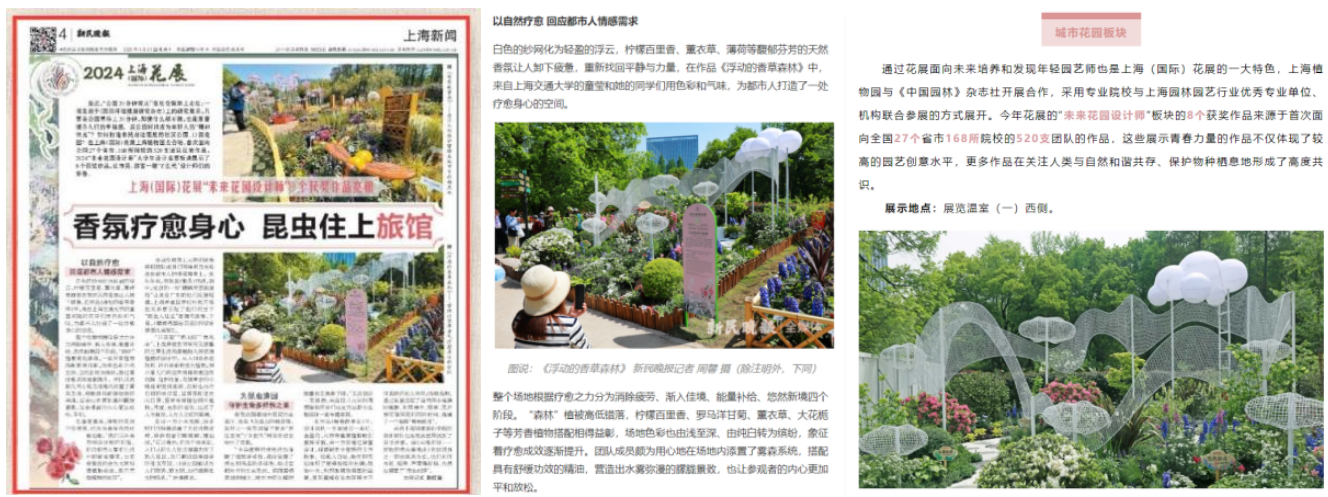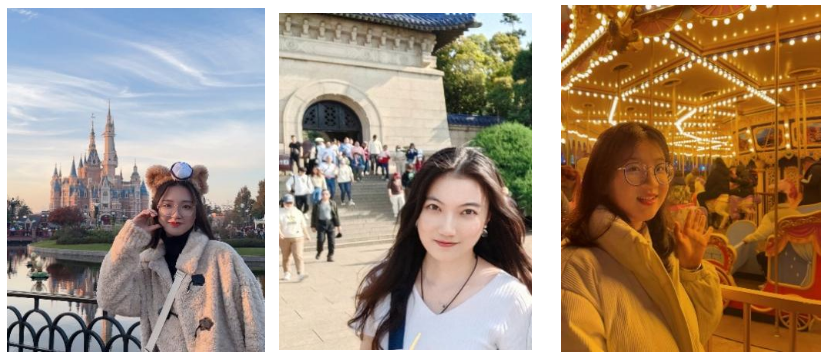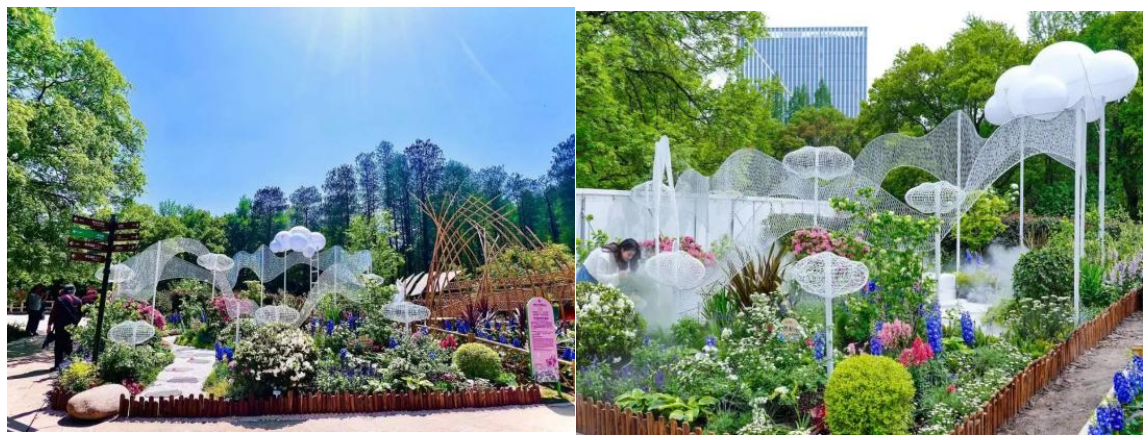Students Win Top Award for their Work at the 2024 Shanghai (International) Flower Show
A spring breeze can be felt for miles around and flowers bloom all over the city. On April 18, the 2024 Shanghai (International) Flower Show officially opened at the Xuhui West Coast Whirlpool. This flower show was held in three main venues, six branch venues and several urban thematic nodes at the Xuhui Riverside, Lingang New Area and Shanghai Botanical Garden. In the “Designers of Future Gardens” section at the Shanghai Botanical Garden, Tong Ying, Lan Xingyue and Xu Jiamin, graduate students in the Department of Landscape Architecture of our college, completed the design work “Floating Vanilla Forest” under the guidance of Zhang Nan and Wang Hui, which was constructed by the Shanghai Landscape Architecture Engineering Co., Ltd. and winner of the highest award of Platinum Prize for “Future Garden Designer's Attractions Production” in this Flower Show. On the day of the opening ceremony, Wang Ling, head of the Department of Landscape Architecture, accepted the award as a representative of our university, together with the leader of the Shanghai Landscape Architecture Engineering Co. The work has also been widely noticed and reported by many official media sources such as the Xinmin Evening News, Shanghai Hotline, China Flower&Gardening News, Sohu, and the Shanghai Botanical Garden's official account.

The opening ceremony of 2024 Shanghai (International) Flower Show

Relevant media reports (images from the Internet)
In this flower show, the Shanghai Botanical Garden reviewed a collection of work from colleges and universities across the country, and selected 8 winning works from 520 teams from 27 provinces and cities and 168 colleges across the country to be displayed to the public. With the joint efforts and cooperation of our teachers and students and the Shanghai Landscape Engineering Co., Ltd, after two months of mutual communication and continuous polishing of the work, a wonderful result was finally presented.

Live photos of “Floating Vanilla Forest”
Brief introduction of work
Name
Floating Vanilla Forest
Team
Design students | Tong Ying, Lan Xingyue, Xu Jiamin

Tong Ying Lan Xingyue Xu Jiamin
Teacher
Zhang Nan, Wang Hui

Zhang Nan
Associate Researcher, Department of Landscape Architecture, School of Design, Shanghai Jiao Tong University
Member of Shanghai Jiao Tong University Aromatic Plant R&D Center
Master's supervisor
Research direction: The olfactory environment and mental and physical health in the environment of human settlement, Health functions of aromatic plant volatiles, and their application in healing landscapes/spaces

Wang Hui
Shanghai Botanical Garden Research Center
Senior Engineer
Research direction: Aromatic plant resources and their development and utilization, Rosa genus aromatic resources, oil roses, aromatic roses and other resource development.
Concept
Idea
In recent years, Shanghai has been deeply promoting the construction of a people's city. Therefore, coming from a group of Generation Z’ers, the design combines the current living conditions of urban populations and responds to the needs of urban populations from the perspective of future garden designers.
In order to meet the needs of the entire age group, the work analyzes and summarizes the current needs of different age groups, and compares people's pursuit of life to a floating cloud-like-leisure. At the same time, spiritual nourishment is achieved by creating a healing space in the urban forest system with fragrant grass and forests. This is used as the element extraction and concept generation of this design.
Plan generation
The Floating Vanilla Forest provides a space for people to heal their body and mind with the fragrance of fragrant herbs, which mainly includes four healing stages: getting rid of shackles, gradually entering a better state, energy supply, and a leisurely new state. At the same time, it also corresponds to the four major healing functions of the venue: eliminating fatigue, calming the mind, replenishing energy, and boosting spirit.
In terms of planting design, the work mainly uses long-term ornamental plants, combining shrubs and herbs. Aromatic plants with corresponding effects are placed in each of the four healing stages of the site, forming a complete healing process. At the same time, plant height configuration and focus design are combined with the terrain to ensure the best viewing effect of the site. In terms of color changes, the colors of flowers gradually become richer as the healing journey progresses from a single white color, reflecting the increasing effectiveness of healing.
In the "forest", the clouds float gently in the breeze. The yarn weaves people's dreams. The cloud-shaped mirrors allow people to find their deepest peace, and the soft cloud-shaped chairs release people's invisible pressure. People stroll through the healing path surrounded by the fragrance of flowers, nourishing their souls, forgetting their fatigue and relaxing at ease.

Plan of the program

Demonstration of the effect
Location
West side of the Exhibition Greenhouse (1), Future Garden Booth, Shanghai Botanical Garden, No.1111 Longwu Road, Xuhui District, Shanghai, China
Note: The recommended viewing route is to enter from Gate 1 of the Shanghai Botanical Garden, go straight ahead for about 300 metres, then turn right and go straight ahead for about 100 metres to reach the site.

Garden Location
From design to construction
From design to construction, the student team followed the original design concept. During the course of this construction, the following major phases were included: road shaping and stacking of terrain → erection of structures → seedling planting → refined construction → essential oil blending, misting system testing, and placement of hand-painted science boards → completion and display.

Meanwhile, small design ingenuity was also implemented in the venue during the construction process, such as the application of essential oils and aromatic plants, and displays for popular science education in the natural sciences.
Release of aroma
A misting system was placed in the venue with carefully blended essential oils, the composition of which contains the aroma of lemon thyme, rosemary, mint and other plants with stress-relieving and energising properties, and these scented plants have been authentically planted in the design venue.

Natural science popularization
The design team also set up hand-painted boards in the venue, not only to remind visitors of the current stage of their healing journey, but also to educate the public on the application and efficacy of aromatic plants at different stages.

Hand-painted science board

Effect of project completion
Reflections of student participation
Tong Ying
From the initial understanding and communication with the construction company, we became familiar with each other, and felt that we were all striving towards one goal, and we all hoped to present the best effect of this work. In the process, we experienced many discussions and adjustments on the landing materials, matching and choosing of plant species, and also learned more about the landing project in cooperation with the construction team, which was a rewarding experience. In the future, we will need to learn more about how to balance the relationship between design and construction in order to present the results we hope to achieve when designing. We are very happy that our work ended up with a good result, and we are very grateful to the builder for helping us. At the same time, we hope to use this work to popularize and promote more applications of aromatic plants to the society. You are welcome to visit our Future Garden at the Shanghai Botanical Garden during the show to experience our vanilla forest!
Lan Xingyue
In the process of designing the 50th anniversary celebration of the Shanghai Botanical Garden, our team went through a journey full of challenges but also a sense of achievement. From the initial concept discussion to the final construction completion, the entire process was filled with countless thoughts, discussions, and adjustments. We have learned a lot from teamwork and learned how to communicate, coordinate, and solve problems better. Every challenge makes us more united, and every solution makes us more mature. In this process, we are not only designers, but also members of the team, supporting and working together. In the end, we feel immensely proud and satisfied to see our design become a highlight of the 50th anniversary celebration of the Shanghai Botanical Garden. This experience not only brought our team closer, but also greatly improved and honed our design skills. At the same time, we have also learned a lot of practical construction experience from the construction team, gained a deeper understanding from design to practice, and gained a deeper understanding of design. This experience will become a valuable asset for our team's growth path, and will also inspire us to work harder and innovate in future design work.
Xu Jiamin
It was a pleasure to see our design go from drawings to the ground. From initial conceptualisation to final construction, the journey was full of exploration and discovery, and included many adjustments and refinements, which allowed us to have a deeper understanding and experience of the design and construction process. We would like to thank the Shanghai Landscape Engineering Co., Ltd. for their expertise and valuable experience in the construction process, which made the whole process smoother and more efficient. When the misting system is switched on, and the "forest world" gradually emerges, we hope that our work will bring you a unique healing experience.

Joint photo of teachers and students at the Future Garden
Finally, we would like to again thank the Shanghai Botanical Garden and the Shanghai Landscape Engineering Co.
Photo source: Shanghai Botanical Garden, Tong Ying
Text: Tong Ying, Lan Xingyue, Xu Jiamin
Check: Wang Chong, Wang Ling, Chang Xiangqi, Zhang Nan
Editor: Dai Shuyan, Xie Jingyao